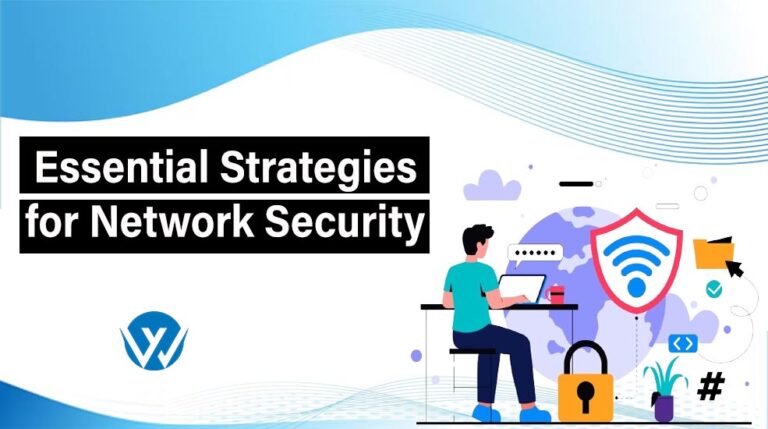Network security strategies are essential because they protect the data from cyber-attacks and security breaches. It prevents cyber attackers from accessing critical data and sensitive information. According to the stats, malware attacks cost a company an average of $2.5 million. That is why a protected network secures the business and ensures smooth operations. A secure network enhances the efficiency of the business without data breaches. Practical solutions and firewalls protect the network and prevent cyber threats and data breaches. With a few compromises, interruptions, and downtime, network efficiency increases and boosts overall business efficiency.
Network Security Strategies:
Strategies for network security are stated below:
Use of firewall:
Operating systems such as Windows and macOS have built-in firewalls to prevent unauthorized access to the business networks and notify the system owner if breach attempts occur. Before internet surfing, always remember to turn the firewalls on to avoid unauthorized access to your data and information.
A firewall examines data packets during packet filtering and compares them against the filters that hold information to recognize the malicious data. Suppose a packet matches the criteria of a threat defined in the filter. It is discarded and keeps the network safe.
Using the Complex Passwords:
Choosing the passwords or answering the security questions makes it challenging for hackers or intruders to crack. To increase the strength of passwords and security firewalls, try translating the answers into another language using online translation facilities for security questions. It makes it difficult for hackers to decode and reduces the attack risk.
While choosing passwords, it is essential to avoid selecting obvious and common password ideas. Avoid selecting sequential lists, parts of usernames, personal information, and generally repeated characters. To strengthen the password:
- Make the password around 15 to 20 characters.
- Use a mix of character types, including lowercase and uppercase letters, numbers, and symbols.
- Avoid typical character switches because hackers are familiar with common substitutions.
Installation of Antivirus Software:
Viruses and malware attack the computer and slow down the computer system; It notifies the owner with a warning not to open the file. The antivirus activates and removes the detected malware if the threat is identified. It prevents hackers from unlawfully accessing the system. Further, antivirus programs regularly scan the computer to ensure the system is free of harmful viruses or malware.
Network Access Control for Better Security:
Limiting network access is a solid tool to minimize the risks of cyber attacks. Access control is a tool that ensures user’s access to certain sections to perform their tasks. Access control uses passwords, pins, security tokens, or even biometric scans to ensure network security and safety.
However, authorized users may also pose a potential threat to the network. Access control tightens network security by restricting and monitoring authorized persons’ access to relevant sections or tasks.
Keep Updating the Security Policy:
One of the significant steps to ensure network security is to update network security policies. It helps to determine the current state of the security program. It empowers the system to update as per the latest security policies and procedures developments. Keep visiting these policies frequently to ensure they are aligned with current business requirements and security conditions.
Systems with updated security policies are less vulnerable to malware and suspicious attacks of hackers.
Security Awareness Training:
Security awareness training for employees is essential to keep them aware of prevailing threats and security solutions to cope with them. Employees must be trained to act as per SOPs to ensure network security. It enables them to identify and mitigate suspicious activities or attacks.
- Train the employees to use strong and complex passwords.
- Instruct to safeguard the sensitive data of customers, employees, and the company.
- Compliance with HIPAA, PCI, and GDPR standards is essential to ensure network security.
- Create awareness regarding phishing emails to ensure the safety of cyber attacks through emails.
Anomaly detection:
In today’s world, anomaly detection is based on machine learning and enables the reorganization and mitigation of threats. Understanding its routine operations makes it possible to identify the anomalies in the company network. An anomaly detection system allows the network administrators to analyze the network security threats, provide real-time notifications of anomalies, and advocate resolution steps.
Anomaly detection empowers the system to detect real-time anomalies, offering quick and effective responses to eliminate the anomalies.
Apply Two-Factor and Multi-Factor Authentications:
Muti-factor authentication applies extra layers of protection by enquiring multiple layers of information to identify the confirmation of an authorized person during login. An MFA-powered bank account needs the user to input ATM PIN and OTP consecutively to process the transaction. In this scenario, MFA is regulated through the OTP.
Multifactor authentication makes it challenging for unauthorized persons to access the account. There are fewer chances to dodge the multi-factor security layer.
Using the VPN:
Installation and using VPNs add an extra layer of security by hiding online activity from third parties or intruders. VPS develops secure connections connecting users to the company’s internal network or the public internet. VPNs allow remote access to employees for in-house applications and data. It also enables the creation of an integrated network across multiple office locations. The adoption of VPN encrypts the network traffic and develops a safer environment for network resources.
Backup cycles and recovery plans:
While connecting to the digital world, chances of data breaches and malware attacks increase for businesses and organizations. Organizations arrange backup plans for essential and sensitive data. If cyber attacks are detected, having a backup and recovery strategy inside the cloud security becomes critical to reduce downtime and costs.
An efficient backup and recovery plan considers all business operations and network security. It must comprise a recovery plan for virus attacks, staff negligence, and other potential threats with a vital recovery time objective. If backup and recovery plans are effectively in place, facing security threats and system and network recovery to routine operations becomes easy.
Conclusion:
In today’s world, protecting the network is one of the most essential tasks for IT personnel and business owners. There are multiple network security parameters to enhance the protection level of data, systems, and sensitive information. Affective implementation of network security systems creates additional firewalls against the organization’s digital assets.
As stated above, network security solutions enhance overall protection and keep the network secure. However, implementing a mix of these strategies depends on the nature of business and operational activities.


